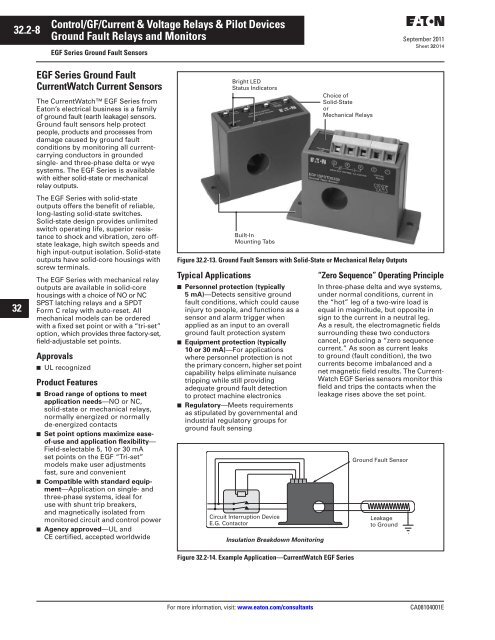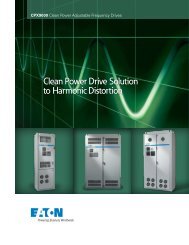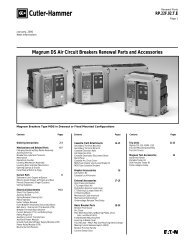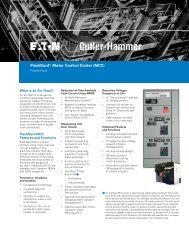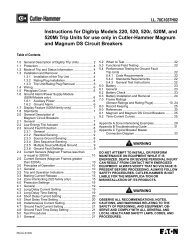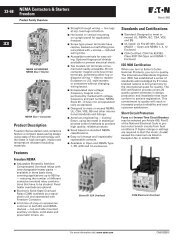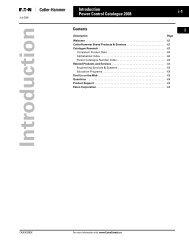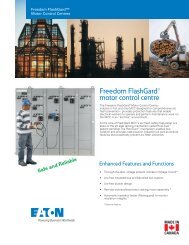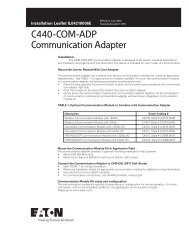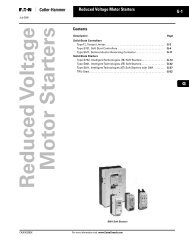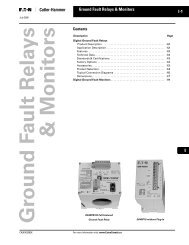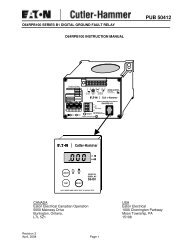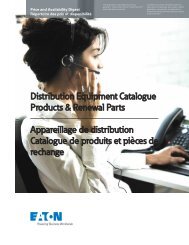Control/GF/Voltage Relays & Pilot - Eaton
Control/GF/Voltage Relays & Pilot - Eaton
Control/GF/Voltage Relays & Pilot - Eaton
You also want an ePaper? Increase the reach of your titles
YUMPU automatically turns print PDFs into web optimized ePapers that Google loves.
32.2-8<br />
22<br />
23<br />
24<br />
25<br />
26<br />
27<br />
28<br />
29<br />
30<br />
31<br />
32<br />
33<br />
34<br />
35<br />
36<br />
37<br />
38<br />
39<br />
40<br />
41<br />
42<br />
43<br />
<strong>Control</strong>/<strong>GF</strong>/Current & <strong>Voltage</strong> <strong>Relays</strong> & <strong>Pilot</strong> Devices<br />
Ground Fault <strong>Relays</strong> and Monitors<br />
E<strong>GF</strong> Series Ground Fault Sensors<br />
E<strong>GF</strong> Series Ground Fault<br />
CurrentWatch Current Sensors<br />
The CurrentWatch E<strong>GF</strong> Series from<br />
<strong>Eaton</strong>’s electrical business is a family<br />
of ground fault (earth leakage) sensors.<br />
Ground fault sensors help protect<br />
people, products and processes from<br />
damage caused by ground fault<br />
conditions by monitoring all currentcarrying<br />
conductors in grounded<br />
single- and three-phase delta or wye<br />
systems. The E<strong>GF</strong> Series is available<br />
with either solid-state or mechanical<br />
relay outputs.<br />
The E<strong>GF</strong> Series with solid-state<br />
outputs offers the benefit of reliable,<br />
long-lasting solid-state switches.<br />
Solid-state design provides unlimited<br />
switch operating life, superior resistance<br />
to shock and vibration, zero offstate<br />
leakage, high switch speeds and<br />
high input-output isolation. Solid-state<br />
outputs have solid-core housings with<br />
screw terminals.<br />
The E<strong>GF</strong> Series with mechanical relay<br />
outputs are available in solid-core<br />
housings with a choice of NO or NC<br />
SPST latching relays and a SPDT<br />
Form C relay with auto-reset. All<br />
mechanical models can be ordered<br />
with a fixed set point or with a “tri-set”<br />
option, which provides three factory-set,<br />
field-adjustable set points.<br />
Approvals<br />
■ UL recognized<br />
Product Features<br />
■ Broad range of options to meet<br />
application needs—NO or NC,<br />
solid-state or mechanical relays,<br />
normally energized or normally<br />
de-energized contacts<br />
■ Set point options maximize easeof-use<br />
and application flexibility—<br />
Field-selectable 5, 10 or 30 mA<br />
set points on the E<strong>GF</strong> “Tri-set”<br />
models make user adjustments<br />
fast, sure and convenient<br />
■ Compatible with standard equipment—Application<br />
on single- and<br />
three-phase systems, ideal for<br />
use with shunt trip breakers,<br />
and magnetically isolated from<br />
monitored circuit and control power<br />
■ Agency approved—UL and<br />
CE certified, accepted worldwide<br />
Figure 32.2-13. Ground Fault Sensors with Solid-State or Mechanical Relay Outputs<br />
Typical Applications<br />
Bright LED<br />
Status Indicators<br />
Built-In<br />
Mounting Tabs<br />
■ Personnel protection (typically<br />
5 mA)—Detects sensitive ground<br />
fault conditions, which could cause<br />
injury to people, and functions as a<br />
sensor and alarm trigger when<br />
applied as an input to an overall<br />
ground fault protection system<br />
■ Equipment protection (typically<br />
10 or 30 mA)—For applications<br />
where personnel protection is not<br />
the primary concern, higher set point<br />
capability helps eliminate nuisance<br />
tripping while still providing<br />
adequate ground fault detection<br />
to protect machine electronics<br />
■ Regulatory—Meets requirements<br />
as stipulated by governmental and<br />
industrial regulatory groups for<br />
ground fault sensing<br />
Circuit Interruption Device<br />
E.G. Contactor<br />
Insulation Breakdown Monitoring<br />
Choice of<br />
Solid-State<br />
or<br />
Mechanical <strong>Relays</strong><br />
Figure 32.2-14. Example Application—CurrentWatch E<strong>GF</strong> Series<br />
September 2011<br />
Sheet 32014<br />
“Zero Sequence” Operating Principle<br />
In three-phase delta and wye systems,<br />
under normal conditions, current in<br />
the “hot” leg of a two-wire load is<br />
equal in magnitude, but opposite in<br />
sign to the current in a neutral leg.<br />
As a result, the electromagnetic fields<br />
surrounding these two conductors<br />
cancel, producing a “zero sequence<br />
current.” As soon as current leaks<br />
to ground (fault condition), the two<br />
currents become imbalanced and a<br />
net magnetic field results. The Current-<br />
Watch E<strong>GF</strong> Series sensors monitor this<br />
field and trips the contacts when the<br />
leakage rises above the set point.<br />
Ground Fault Sensor<br />
Leakage<br />
to Ground<br />
For more information, visit: www.eaton.com/consultants CA08104001E


